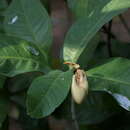mk
имиња во трошки


Magnolia liliifera, commonly known as egg magnolia, is a flowering tree native to the Indomalayan realm.[5][6] It bears white to cream-colored flowers on terminal stems.[7] The leaves are elliptical and get as large as 25 cm (10 in) long and 8 cm (3 in) wide. The tree ranges in height from 3.5 to 18.5 m (12 to 60 ft) in situ.[7]
Magnolia liliifera was classified as having several varieties, however these have now been generally accepted as species by several botanists including Hans Peter Nooteboom and Richard B. Figlar according to data compiled by Rafaël Govaerts, a researcher for the WCSP at Kew Gardens.[2]
Magnolia liliifera is grown as an ornamental plant and is suited to culture in pots. Although tropical, the egg magnolia is reported to withstand sub-tropical climates at USDA zone 10 and higher.[14] It has been grown in the West since the Victorian era with the first report of a flowering specimen at Kew Gardens in April, 1862.[15] The egg magnolia is valued for its fragrant, egg-like flower which releases a wafting pineapple-like scent in the morning.[14]
Magnolia liliifera, commonly known as egg magnolia, is a flowering tree native to the Indomalayan realm. It bears white to cream-colored flowers on terminal stems. The leaves are elliptical and get as large as 25 cm (10 in) long and 8 cm (3 in) wide. The tree ranges in height from 3.5 to 18.5 m (12 to 60 ft) in situ.
Magnolia liliifera est une espèce d'arbres de la famille des Magnoliaceae.
Magnolia liliifera est également connu sous le nom de magnolia à œuf.
Les arbres atteignent une hauteur s'étalant de 3.5 m à 18.5 m in situ[2].
Ce magnolia porte des fleurs blanches à crème sur des tiges terminales[2]. Les fleurs sont elliptiques avec 25 cm de longueur et 8 de largeur.
Magnolia liliifera est une plante à fleurs autochtone aux régions du sud-est de l'Asie[3],[4]. On la trouve dans la péninsule indochinoise en Thaïlande, au Vietnam, au Cambodge et au Laos, en Indonésie et aux Philippines.
Selon World Checklist of Selected Plant Families (WCSP) (30 décembre 2013)[5] :
Selon NCBI (30 décembre 2013)[6] :
Selon Tropicos (30 décembre 2013)[7] (Attention liste brute contenant possiblement des synonymes) :
Magnolia lilifera est adapté à la culture en pots, ce qui correspond à son utilisation comme plante ornementale. Bien que inféodé aux climats tropicaux, M. lilifera supporterait des climats subtropicaux de la zone 10 de l'USDA. Une des premières traces manuscrites de cette espèce remonte à l'ère victorienne en Avril 1862[8]. M. lilifera est reconnu pour sa fragrance, la fleur dégage une odeur d'ananas le matin.
Magnolia liliifera est une espèce d'arbres de la famille des Magnoliaceae.
Cempaka telur atau cempaka gondok (Magnolia liliifera) adalah salah satu jenis cempaka yang berasal dari Asia Tenggara. Cempaka telur kadang-kadang disebut saja sebagai cempaka, meskipun sebenarnya bunganya agak berbeda. Cempaka telur merupakan pohon kecil dan bunganya tumbuh terminal (di ujung) seperti banyak Magnolia lain, dan berbeda dari cempaka asli (Michelia) yang bunganya tumbuh aksial (di samping).
Tumbuhan ini biasa dijumpai di kebun sebagai tanaman hias taman.
Magnolia liliifera[2] este o specie de plante din genul Magnolia, familia Magnoliaceae. A fost descrisă pentru prima dată de Carl von Linné, și a primit numele actual de la Henri Ernest Baillon.[3][4] A fost clasificată de IUCN ca specie cu risc scăzut.[1] Conform Catalogue of Life specia Magnolia liliifera nu are subspecii cunoscute.[3]
Magnolia liliifera este o specie de plante din genul Magnolia, familia Magnoliaceae. A fost descrisă pentru prima dată de Carl von Linné, și a primit numele actual de la Henri Ernest Baillon. A fost clasificată de IUCN ca specie cu risc scăzut. Conform Catalogue of Life specia Magnolia liliifera nu are subspecii cunoscute.
Magnolia liliifera là một loài thực vật có hoa trong họ Magnoliaceae. Loài này được (L.) Baill. mô tả khoa học đầu tiên năm 1868.[1]
Magnolia liliifera là một loài thực vật có hoa trong họ Magnoliaceae. Loài này được (L.) Baill. mô tả khoa học đầu tiên năm 1868.